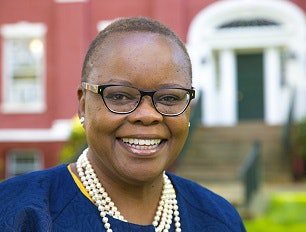ATLANTA — The National Association of Diversity Officers in Higher Education’s Standards of Professional Practice Institute reinforced several central tenets that organizers said are essential to supporting chief diversity officers in their efforts to accomplish institutional goals for diversity, equity and inclusion.
Relationship-building, thinking strategically about the larger goal of diversity work and connecting with a wide representation of diversity practitioners from various institutional types were among the most prominent takeaways stated by institute participants here.
 Dr. Armenta Hinton
Dr. Armenta Hinton“The work can be very isolating and generally toxic because you’re problem-solving, you are a change agent, you are handling things that can make or break a person’s experience [or] the institution’s trajectory,” said Dr. Armenta Hinton, Director of Diversity, Inclusion and Title IX at Elizabethtown College. “All of that is very, very important…and it’s very important to have comrades, colleagues who are doing similar things who can be your support.”
Hinton pointed out that the chief diversity officer at an institution typically manages a staff or team.
“So, who nourishes you?” she asked. “Sometimes you need that external nourishment.”
Dr. Donald A. Outing, Lehigh University’s Vice President for Equity and Community, said he encouraged participants to spend time engaged in conversations to learn the perspectives of other diversity officers.
“As you start building your network, you have a better understanding of who you can turn to or rely on for advice and information, and also capturing individuals and organizations that have been through some of the things that you’re going to experience,” Outing said. “You can reach out to them so you don’t repeat past mistakes.”
New diversity practitioners attending the institute acknowledged that such coalition-building in the profession — and with this year’s cohort — has assured them of the purpose and the importance of their work.
It “has been just the best takeaway to know that I have colleagues who have been in the profession for such a long time, and to be able to utilize them as a resource so I’m not in this silo by myself trying to figure it out,” said Aisha DeBerry, Director of Diversity and Community Partnerships at the Georgia Campus – Philadelphia College of Osteopathic Medicine.
Serving as a diversity officer in the medical space particularly, DeBerry said she gained a better understanding of the dynamics of the diversity trainings and practices that can be implemented through her office.
Hinton said she takes a “strengths-based” approach to her work as a diversity officer, adding that an individual in the role should be as authentic as possible when approaching some of the more difficult challenges of the role.
“I don’t think the diversity officer walks around with a big cape solving problems,” said Hinton. “They’re not crime-fighters. I believe they’re coalition-builders, I believe that they change cultures. But the most effective way for this to work is when it’s strengths-based — look at what you’re doing well [and] figure out how you’re going to build on that.”
Tiffany Pennamon can be reached at [email protected]. You can follow her on Twitter @tiffanypennamon.





















